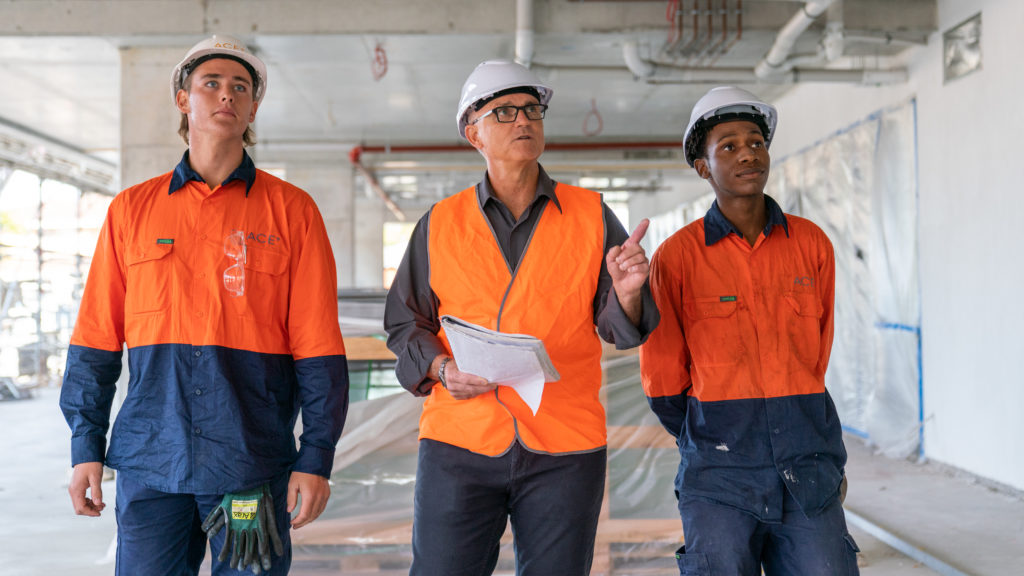Want to turn your interests into a rewarding career? Combine expert training with work and make yourself more employable with qualified, transferable skills that give you a competitive edge.
There are multiple ways to start an apprenticeship and earn while you learn. It may seem like an overwhelming process at first, but once you know what to do and who you should talk to it’s simple.
You can do an apprenticeship or traineeship as a school leaver or as an adult. If you want to get a head start, there are programs in Years 11 and 12 that equip you with essential experience. Regardless of when you begin, an apprenticeship is the most practical way to complete training towards a nationally recognised qualification. It's also a great opportunity to get mentorship while you get qualified.
Starting an apprenticeship could be the perfect step if you say yes to any of the following statements:
✓ I am interested in or thinking about doing a trade
✓ I do not want to go to uni
✓ I want or need to finish Year 12
✓ I am unsure about what career path I should take
✓ I want to upskill and try a trade before I decide
There is no one way to get an apprenticeship and there are plenty of pathways to take. Learn how to get started below.
Begin a career in construction as early as Year 9, as a school leaver, once you complete school or as a mature-age entrant.
You can find out all your pathway options at our Construction Futures Centre before you commit to a program or course. The free and interactive centre has a range of activities to help you choose what work interests you.
Your path into construction may be different from other students but ultimately it will include the following stages:
- Research: Explore resources and programs from Construction Training Fund, talk to someone in the industry or speak with your school’s career advisor or VET coordinator to discuss your options
- Certificate II Qualification: A pre-apprenticeship (Cert II) is often the best step to gaining practical on-site work experience. If you do this in high school you might be able to get signed off early
- Find an Employer and/or Apply to a GTO: There is support for students and employers to strengthen your network and get the ball rolling. You might choose to find an employer yourself or use a Group Training Organisation that matches you with an employer and the worksite training you’ll need. GTOs also assist with employer support and enrolment into courses and programs on your behalf, as well as organise your study blocks to maximise your time
Want to explore further?
Try our fully-funded Try-A-Trade program to get a taste of different trades, apply for a scholarship to pursue your pathway and prepare for an apprenticeship.
You can get your apprenticeship straight after Year 12, without the need for an ATAR ranking. Get a head start while you’re still in school by completing a Pre Apprenticeship in years 11 & 12. Our Industry Training Advisors can support you in choosing the best school subjects to upskill effectively.
Pre-apprenticeships allow you to save time and work while still at school. Programs require you to do one to two days a week with a Registered Training Organisation. That means time away from school for fun, engaging and educational experiences that sets you up for success in the industry.
While some construction careers require you to go to uni, such as engineering and architecture, there are many that can be completed as a traineeship instead of an apprenticeship.
Both pathways involve learning on the job and attending off-the-job training while you get paid.
Starting a Traineeship
With a traineeship, you have a broader range of occupational options and typically less training. Traineeships involve training in vocational areas such as marketing, events management, administration, business, and information technology.
You’ll gain hands-on skills and work experience, which is an excellent way to learn more about the role and show off your skills. Upon successful completion, you’ll receive your qualification and improve your career prospects. Allow one to two years to complete.
Starting an Apprenticeship
An apprenticeship takes around four years to complete and involves training for a skilled trade such as bricklaying, metal fabrication, electrical or carpentry, or a non-trade like hospitality, hairdressing, or landscaping.
The training programs are structured and combine workplace training with off-the-job experience. Upon successful completion, you’ll become a qualified tradesperson in your trade of choice.
Construction Training Fund offsets employers’ training costs when they hire an apprentice or a trainee within selected construction qualifications. One bonus of doing an apprenticeship or a traineeship is that you expand your career opportunities.
If you want to progress in your career and see your income grow, starting an apprenticeship can provide a realm of opportunities.
When you start in an apprenticeship you are positioning yourself as an attractive candidate to an employer. Candidates who have completed pre-apprenticeship training and have a driver’s licence are likely to have added appeal to prospective workplaces.
To find the right pathway for your interests and skills, visit a Jobs and Skills Centre located within TAFEs around WA. The WA Department of Training and Workforce Development's Apprenticeship Office and the Federal Government’s Australian Apprenticeships sites have handy information for students, job hunters, career advisors and employers too.
If you have any questions about starting an apprenticeship, please email ita@ctf.wa.gov.au or phone 08 9244 0100. We’re here to help.
Get out there and see what career opportunities are available in building and construction. There are a range of support programs available from CTF. You might be surprised about what you can do or how many options there are for various interests and skills.

Last modified on:

